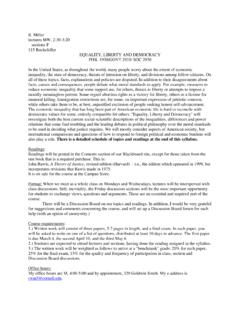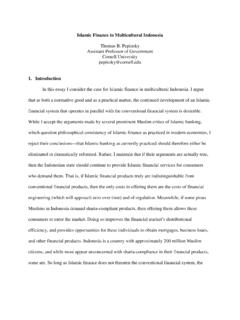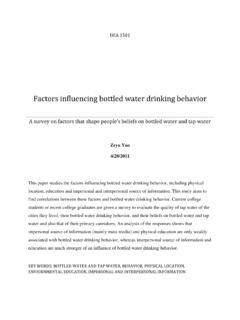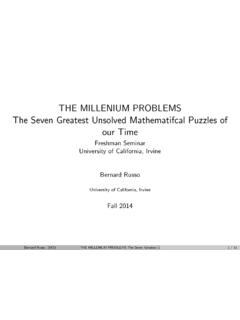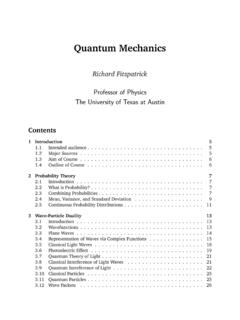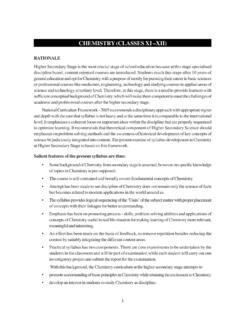Transcription of Handout 3 Free Electron Gas in 2D and 1D
1 1 ECE 407 Spring 2009 Farhan Rana Cornell UniversityHandout 3 Free Electron Gas in 2D and 1 DIn this lecture you will learn: Free Electron gas in two dimensions and in one dimension Density of States in k-space and in energy in lower dimensionsECE 407 Spring 2009 Farhan Rana Cornell UniversityElectron Gases in 2D In several physical systems Electron are confined to move in just 2 dimensions Examples, discussed in detail later in the course, are shown below:Semiconductor quantum Wells:GaAsGaAsInGaAs quantum well (1-10 nm)Graphene:Semiconductor quantum wells can be composed of pretty much any semiconductor from the groups II, III, IV, V, and VI of the periodic tableGraphene is a single atomic layer of carbon atoms arranged in a honeycomb lattice TEM micrographSTM micrograph2 ECE 407 Spring 2009 Farhan Rana Cornell UniversityElectron Gases in 1D In several physical systems Electron are confined to move in just 1 dimension Examples, discussed in detail later in the course, are shown below:Semiconductor quantum Wires (or Nanowires):GaAsInGaAsNanowireGaAsSemicon ductor quantum Point Contacts (Electrostatic Gating):GaAsInGaAsQuantum wellCarbon Nanotubes (Rolled Graphene Sheets):metalmetalECE 407 Spring 2009 Farhan Rana Cornell UniversityElectrons in 2D Metals: The Free Electron ModelThe quantum state of an Electron is described by the time-independent Schrodinger equation: rErrVrm 222 Consider a large metal sheet of area A= LxLy: xLyLUse the Sommerfeld model.
2 The electrons inside the sheet are confined in a two-dimensional infinite potential well with zero potential inside the sheet and infinite potential outside the sheet The Electron states inside the sheet are given by the Schrodinger equation sheet the outside forsheet the inside for0rrVrrV free electrons (experience no potential when inside the sheet)yxLLA 3 ECE 407 Spring 2009 Farhan Rana Cornell UniversityBorn Von Karman Periodic Boundary Conditions in 2D rErm 222 Solve:Use periodic boundary conditions: zyxzLyxzyxzyLxyx,,,,,,,, These imply that each edge of the sheet is folded and joined to the opposite edgeSolution is: ykxkirkiyxeAeAr 11. The boundary conditions dictate that the allowed values of kx , and ky are such that: yyLkixxLkiLmkeLnkeyyxx 2121 n = 0, 1, 2, 3,..m = 0, 1, 2, 3,..xLyLyxLLA xyECE 407 Spring 2009 Farhan Rana Cornell UniversityBorn Von Karman Periodic Boundary Conditions in 2 DLabeling Scheme:All Electron states and energies can be labeled by the corresponding k-vector mkkE222 rkikeAr.
3 1 Momentum Eigenstates:Another advantage of using the plane-wave energy eigenstates (as opposed to the sine energy eigenstates) is that the plane-wave states are also momentum eigenstatesMomentum operator: ip rkrirpkkk Normalization:The wavefunction is properly normalized: 122 rrdk Orthogonality:Wavefunctions of two different states are orthogonal: kkrkkikkAerdrrrd ,'.'2*'2 Velocity:Velocity of eigenstates is: kEmkkvk 14 ECE 407 Spring 2009 Farhan Rana Cornell UniversityStates in 2D k-SpacexL 2yL 2k-space Visualization:The allowed quantum states states can be visualized as a 2D grid of points in the entire k-space yyxxLmkLnk 22 Density of Grid Points in k-space:Looking at the figure, in k-space there is only one grid point in every small area of size: ALLyx2222 22 A There are grid points per unit area of k-spaceVery important resultn, m= 0, 1, 2, 3, ..xkykECE 407 Spring 2009 Farhan Rana Cornell UniversityThe Electron Gas in 2D at Zero Temperature - I Suppose we have Nelectrons in the sheet.
4 Then how do we start filling the allowed quantum states? Suppose T~0K and we are interested in a filling scheme that gives the lowest total energy of a quantum state is: mkmkkkEyx2222222 Strategy: Each grid-point can be occupied by two electrons (spin up and spin down) Start filling up the grid-points (with two electrons each) in circular regions of increasing radii until you have a total of Nelectrons When we are done, all filled ( occupied) quantum states correspond to grid-points that are inside a circular region of radius kFFkxLyLyxLLA xy5 ECE 407 Spring 2009 Farhan Rana Cornell UniversityxkykFkFermi circle Each grid-point can be occupied by two electrons (spin up and spin down) All filled quantum states correspond to grid-points that are inside a circular region of radius kFArea of the circular region = Number of grid-points in the circular region = 2Fk 222 FkA Number of quantum states (including spin) in the circular region = 222222 FFkAkA But the above must equal the total number Nof electrons inside the box.
5 22 FkAN 2density electron2 FkANn 212nkF The Electron Gas in 2D at Zero Temperature - IIUnits of the Electron density nare #/cm2 ECE 407 Spring 2009 Farhan Rana Cornell UniversityxkykFkFermi circle All quantum states inside the Fermi circle are filled ( occupied by electrons) All quantum states outside the Fermi circle are emptyFermi Momentum:The largest momentum of the electrons is:This is called the Fermi momentumFermi momentum can be found if one knows the Electron density:Fk 212nkF Fermi Energy:The largest energy of the electrons is:This is called the Fermi energy EF:mkF222 mkEFF222 Fermi Velocity:The largest velocity of the electrons is called the Fermi velocity vF:mkvFF The Electron Gas in 2D at Zero Temperature - IIImnEF 2 orFEmn2 Also:6 ECE 407 Spring 2009 Farhan Rana Cornell University 22 ARecall that there are grid points per unit area of k-space So in area of k-space the number of grid points is: yxdkdk kdAdkdkAyx 22222 xkykxdkydk The summation over all grid points in k-space can be replaced by an area integral 22 all2 kdAk Therefore: kfkdAkfNk 22 all222 The Electron Gas in 2D at Non-Zero Temperature - I kf is the occupation probability of a quantum stateECE 407 Spring 2009 Farhan Rana Cornell UniversityThe Electron Gas in 2D at Non-Zero Temperature - IIThe probability that the quantum state of wavevector is occupied by an Electron is given by the Fermi-Dirac distribution function:k kf TKEkEfekf 11 Therefore: KTEkEfekdAkfkdAN 1122222222 mkmkkkEyx2222222 Where:Density of States:The k-space integral is cumbersome.
6 We need to convert into a simpler form an energy space integral using the following steps:dkkkd 22 anddkmkdEmkE2222 Therefore: 0202222dEmAdkkAkdA 7 ECE 407 Spring 2009 Farhan Rana Cornell UniversityThe Electron Gas in 2D at Non-Zero Temperature - III KTEEDKTEkEffeEgdEAekdAN 1111222022 Where: 22 mEgD Density of states function is constant (independent of energy) in 2Dg2D(E) has units: # / Joule-cm2 The productg(E) dErepresents the number of quantum states available in the energy interval between Eand (E+dE) per cm2of the metalxkykSuppose Ecorresponds to the inner circle from the relation:mkE222 And suppose (E+dE) corresponds to the outer circle, then g2D(E) dEcorresponds to twice the number of the grid points between the two circlesECE 407 Spring 2009 Farhan Rana Cornell University fEEf EfE EgD2 The expression for Ncan be visualized as the integration over the product of the two functions:The Electron Gas in 2D at Non-Zero Temperature - IV fDKTEEDEEfEgdEAeEgdEANf 202011 Where: 22 mEgD Check: Suppose T=0K:E01fET= 0K ffDEfDEmnEmAEgdEAEEfEgdEANf222020 Compare with the previous result at T=0K:FEmn2 At T=0K (and only at T=0K) the Fermi level Efis the same as the Fermi energy EF fEEf 8 ECE 407 Spring 2009 Farhan Rana Cornell UniversityThe Electron Gas in 2D at Non-Zero Temperature - V TKEKTEEDffeTKmeEgdEn1log11220 For T 0K:Since the carrier density is known, and does not change with temperature, the Fermi level at temperature Tis found from the expressionIn general, the Fermi level Efis a function of temperature and decreases from EFas the temperature increases.
7 The exact relationship can be found by inverting the above equation and recalling that: 1logKTEfFeKTTEFEmn2 to get:ECE 407 Spring 2009 Farhan Rana Cornell UniversityTotal Energy of the 2D Electron GasThe total energy Uof the Electron gas can be written as: kEkfkdAkEkfUk 22 all222 Convert the k-space integral to energy integral: EEEfEgdEAUfD 20 The energy density uis: EEEfEgdEAUufD 20 Suppose T=0K: 22202 FDEEmEEgdEuF FEmn2 Since:We have:FEnu21 9 ECE 407 Spring 2009 Farhan Rana Cornell University2D Electron Gas in an Applied Electric Field - IxkykElectron distribution in k-space when E-field is zeroxkykElectron distribution is shifted in k-space when E-field is not zeroxEEx Eektk Distribution function: kf Distribution function: Eekf Ee Since the wavevector of each Electron is shifted by the same amount in the presence of the E-field, the net effect in k-space is that the entire Electron distribution is shifted as shown kf xLyLE ECE 407 Spring 2009 Farhan Rana Cornell University2D Electron Gas in an Applied Electric Field - IIxkykElectron distribution is shifted in k-space when E-field is not zeroE Distribution function: Eekf Ee Current density (units: A/cm) kvEekfkdeJ 2222Do a shift in the integration variable: EEmenJEkfkdmeJmEekkfkdeJEekvkfkdeJ 22222222222222 Where:men 2 Same as the Drude result - but units are different.
8 Units of are Siemens in 2 Delectron density = n (units: #/cm2)10 ECE 407 Spring 2009 Farhan Rana Cornell UniversityElectrons in 1D Metals: The Free Electron ModelThe quantum state of an Electron is described by the time-independent Schrodinger equation: xExxVxxm 2222 Consider a large metal wire of length L : LUse the Sommerfeld model: The electrons inside the wire are confined in a one-dimensional infinite potential well with zero potential inside the wire and infinite potential outside the wire The Electron states inside the wire are given by the Schrodinger equation wirethe outside for wirethe inside for0xxVxxV free electrons (experience no potential when inside the wire)ECE 407 Spring 2009 Farhan Rana Cornell UniversityBorn Von Karman Periodic Boundary Conditions in 1 DSolve:Use periodic boundary conditions: zyxzyLx,,,, These imply that each facet of the sheet is folded and joined to the opposite facetSolution is: xkixeLx1 The boundary conditions dictate that the allowed values of kx are such that: LnkexLkix 21 n = 0, 1, 2, 3.
9 XExxm 2222 L11 ECE 407 Spring 2009 Farhan Rana Cornell UniversityStates in 1D k-SpaceL 2k-space Visualization:The allowed quantum states states can be visualized as a 1D grid of points in the entire k-space Lnkx 2 Density of Grid Points in k-space:Looking at the figure, in k-space there is only one grid point in every small length of size: L 2 2L There are grid points per unit length of k-spaceVery important resultn = 0, 1, 2, 3, ..xk0 ECE 407 Spring 2009 Farhan Rana Cornell UniversityxkFkFermi points Each grid-point can be occupied by two electrons (spin up and spin down) All filled quantum states correspond to grid-points that are within a distance kFfrom the originLength of the region = Number of grid-points in the region = Fk2 FkL22 Number of quantum states (including spin) in the region = But the above must equal the total number Nof electrons in the wire: FkLN2 FkLNn2density Electron 2nkF The Electron Gas in 1D at Zero Temperature - IUnits of the Electron density nare #/cm0 FkFkL222 12 ECE 407 Spring 2009 Farhan Rana Cornell University All quantum states between the Fermi points are filled ( occupied by electrons) All quantum states outside the Fermi points are emptyFermi Momentum:The largest momentum of the electrons is:This is called the Fermi momentumFermi momentum can be found if one knows the Electron density:Fk Fermi Energy.
10 The largest energy of the electrons is:This is called the Fermi energy EF:mkF222 mkEFF222 Fermi Velocity:The largest velocity of the electrons is called the Fermi velocity vF:mkvFF The Electron Gas in 1D at Zero Temperature - IImnEF8222 orFEmn 8 Also:xkFermi points02nkF ECE 407 Spring 2009 Farhan Rana Cornell University 2 LRecall that there are grid points per unit length of k-space So in length of k-space the number of grid points is: xdkxdkL 2xkxdk The summation over all grid points in k-space can be replaced by an integral 2 allxkdkL Therefore: xxkxkfdkLkfN 222 all The Electron Gas in 1D at Non-Zero Temperature - I xkfis the occupation probability of a quantum state013 ECE 407 Spring 2009 Farhan Rana Cornell UniversityThe Electron Gas in 1D at Non-Zero Temperature - IIThe probability that the quantum state of wavevector is occupied by an Electron is given by the Fermi-Dirac distribution function:xk xkf TKEkExfxekf 11 Therefore: KTEkExxxfxedkLkfdkLN 112222 mkkEx222 Where:Density of States:The k-space integral is cumbersome.


